The Intel SSD 600p (512GB) Review
by Billy Tallis on November 22, 2016 10:30 AM ESTRandom Read Performance
The random read test requests 4kB blocks and tests queue depths ranging from 1 to 32. The queue depth is doubled every three minutes, for a total test duration of 18 minutes. The test spans the entire drive, which is filled before the test starts. The primary score we report is an average of performances at queue depths 1, 2 and 4, as client usage typically consists mostly of low queue depth operations.
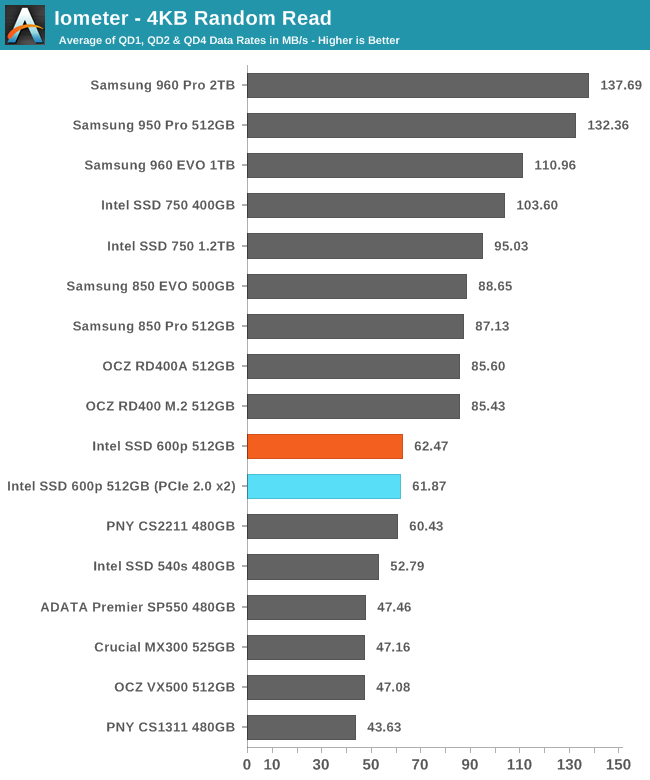
The Intel 600p has faster random reads than budget SATA SSDs, but it is significantly behind the Samsung 850 EVO.
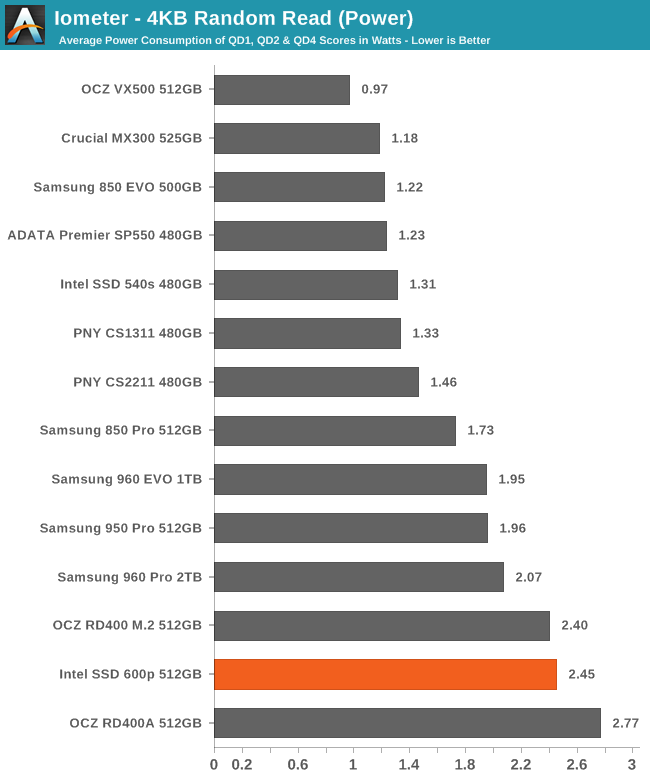
As usual, the 600p's power consumption is high, but not egregiously so: 2.45W is usually not high enough for thermal throttling to be a concern for M.2 SSDs.
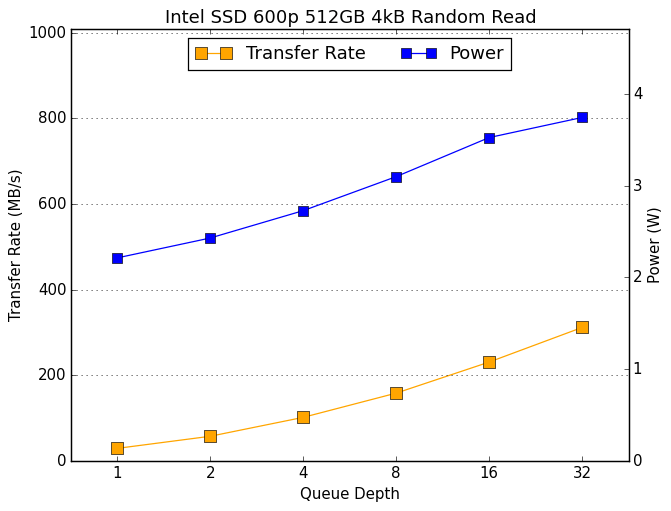 |
|||||||||
The 600p's performance grows slowly as queue depth increases, and even at QD32 it has not reached the SATA speed limit that Samsung's SATA drives hit at QD16.
Random Write Performance
The random write test writes 4kB blocks and tests queue depths ranging from 1 to 32. The queue depth is doubled every three minutes, for a total test duration of 18 minutes. The test is limited to a 16GB portion of the drive, and the drive is empty save for the 16GB test file. The primary score we report is an average of performances at queue depths 1, 2 and 4, as client usage typically consists mostly of low queue depth operations.
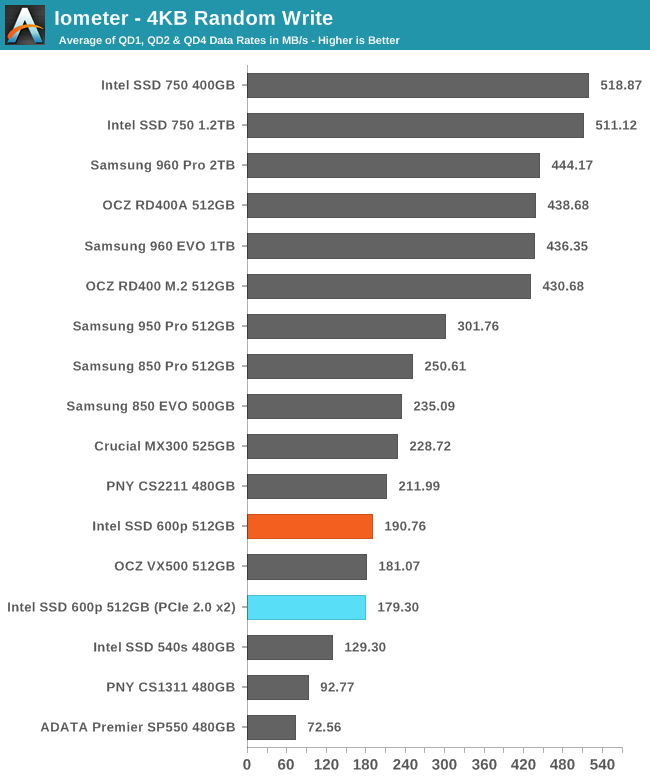
The 600p had above-average steady-state QD32 random write performance, but this shorter test of low queue depths puts the 600p only barely ahead of the slowest MLC SSD in this collection.
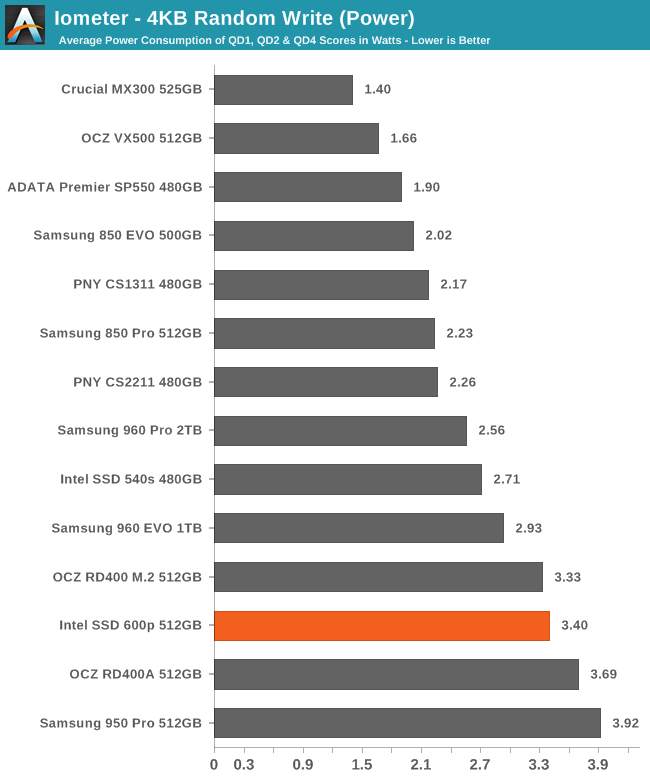
The 600p uses more power than most drives, but unlike the Samsung 950 Pro it isn't brushing up against the practical TDP limits of the M.2 form factor even at lowest queue depths.
 |
|||||||||
It is clear that the 600p's random write performance improves from QD1 to QD2, but after that all we're seeing in this graph is the same steady state variations we saw in the hour-long QD32 consistency test, potentially with some thermal throttling.










63 Comments
View All Comments
Billy Tallis - Tuesday, November 22, 2016 - link
The old firmware. The testbed has been too busy with PCIe SSDs lately for me to have a chance to put the November MX300 update through its paces.seanmac2 - Wednesday, November 23, 2016 - link
I would never intentionally buy this product but it bothers me anyway because laptops advertise things like "512 GB PCIe SSD" and I'm left wondering if I'll get this or something sweet like a Samsung 950/951/960.ddriver - Wednesday, November 23, 2016 - link
You get what you pay for. The 600p will likely go into budget products, which won't be CPU powerhouses which may be limited by the sdd performance. Most applications, even prosumer grade software, shows like 1-2$ improvement from going sata to nvme, and this particular product, although technically nvme is more in the sata ballpark.Flying Aardvark - Friday, November 25, 2016 - link
That's why Intel products cost more than others. You do get what you pay for. Intel SSDs have the industry's best reliability, which matters most when your drive fails prematurely. Unlikely if using M.2 you'll see any real world difference between the 600P and anything else.The true step up is the heavy duty Intel 750 stuff with heatsink and zero throttling concerns under heavy, sustained load.
Meteor2 - Wednesday, November 23, 2016 - link
A suggestion: you could link to the previous reviews of devices the first time you mention them, e.g. the 850 Evo. Would save hunting around for them/encourage more page views a people read those reviews before coming back.Meteor2 - Wednesday, November 23, 2016 - link
So where's this drive falling down compared to the other NVMe drives? Is it the TLC NAND, the construction of the dies, the controller, or something else?DominionSeraph - Wednesday, November 23, 2016 - link
"1750MB/s sequential read", and not a single test showing if it could actually reach 1750MB/s sequential read in any real life tasks.Great job there.
beginner99 - Wednesday, November 23, 2016 - link
WTF is this? It's another useless TLC crap drive. Intel, your ruining your reputation and brand with crap like this. I don't see why I should buy this over a MX300 or similar crappy TLC entry level ssd that is even cheaper.Flying Aardvark - Friday, November 25, 2016 - link
Everything is going to be 3D TLC soon except the truly next-level stuff like the Intel 750. 3D TLC is not planar TLC.creed3020 - Wednesday, November 23, 2016 - link
Billy, when are these results going to be included in Bench? I was hoping to compare to my Crucial MX100 but cannot find these Intel drives under SSD2015.